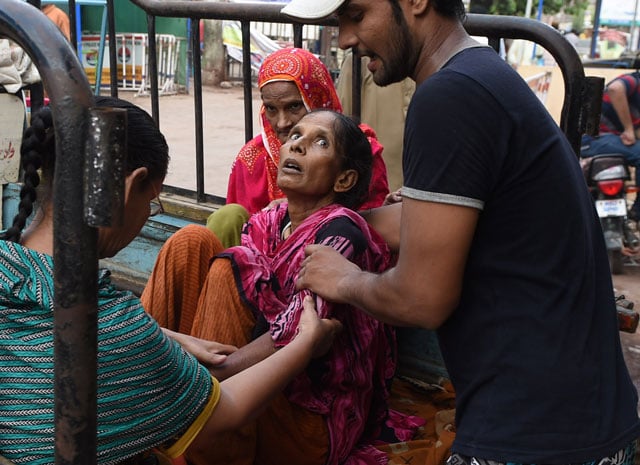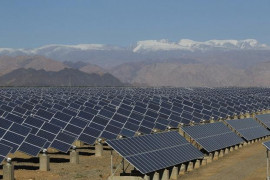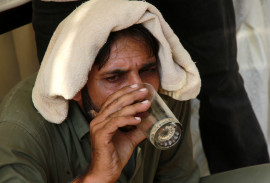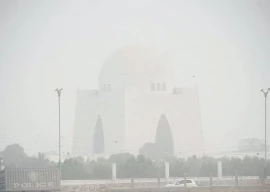
LONDON/ KARACHI: When an unseasonal and potentially deadly heatwave loomed on weather forecasts last month, authorities in Karachi took an unusual step: They issued a public warning, a full week in advance.
Before the heat hit, text message warning of the danger went out to Karachi residents. Hospitals set aside extra beds for heat stroke victims. Water and power company officials were put on alert.
Ultimately the heatwave, with temperatures that reached 41 degrees Celsius, passed without claiming lives, Karachi Mayor Waseem Akhtar said. But the warning - the first of its kind issued by the Pakistan Meteorological Department for Karachi - may set the stage for more lifesaving warnings next summer as climate change drives temperatures higher.
October temperatures in Karachi normally rise no higher than 35 or 38 degrees Celsius, said Abdul Rashid, director of the Pakistan Meteorological Department office in Karachi. Heatwaves in October are “extremely rare incidents”, he said. But being unprepared for extreme heat can be deadly.
Karachi likely to experience heatwave from today
In 2015, a June heatwave killed about 1,500 people and left over 70,000 hospitalised, most with heat stroke. Officials are now working to try to avoid a repeat of that heat disaster - a particular challenge as climate change brings ever-hotter years, particularly in already broiling South Asia.
“We now keep a closer watch on temperature, air, humidity (and) sunlight parameters of the Bay of Bengal and Arabian Sea, and register these parameters regularly in the weather charts, which helped predict the October heat wave more accurately and timely,” Rashid, of the met office, told the Thomson Reuters Foundation. The Karachi office also has its own heatwave forecast division, with advanced computer systems connected to five heatwave monitoring stations recently installed around the city, he said. The system was set up following World Meteorological Organisation warnings that more frequent and intense heatwaves were becoming a possibility in the region.
Warning, then action
In October, after spotting heat-producing weather conditions moving toward Pakistan from Mumbai and India’s Gujarat state, the office issued a warning to the Sindh provincial government, the Karachi commissioner and provincial disaster management authorities, Rashid said. For Karachi’s mayor, the alert provided time to send out text alerts, contact media, warn hospitals and water and power utility officials and set up special units for heat victims in 13 city hospitals.
Dr Seemi Jamali, head of emergencies at Jinnah Postgraduate Medical Centre, said the warning gave time to stock extra medicine, set aside beds and put medical staff on high alert. “This really helped quickly arrange medical care facilities in hospitals for heat wave victims and avoid possible deaths,” she said in an interview in her office. Residents of Karachi said the unusual October heat is a worry.
Coastal areas to brace up for another heat wave
“Octobers have remained always warm in the port city, but I never experienced this blistering heatwave in all my life in this month, which made our home feel like a furnace,” said Saba Karim, a 43-year-old garment factory worker. “We all five family members, including my husband, stayed indoors during the heatwave days and would go outside only during night hours to buy groceries,” she recalled.
Ghulam Rasul, head of the Pakistan Meteorological Department, said the country may be seeing a change in its traditional pattern of onshore winds blowing cooler air into Karachi over the summer months. The lack of that wind was one driver behind Karachi’s October heatwave, he said.
“Temperatures in the Arabian Sea are showing gradual rising trends for the last six years because of strange weather patterns, which most likely increase the frequency and intensity of cyclones, heatwaves, and torrential rains in months in which these were never or rarely seen before,” said Rasul, who is also Pakistan’s permanent representative to the World Meteorological Organisation.
Blood clots to leaking guts
Deadly heatwaves are more lethal than you may think. They kill in at least 27 ways, from blood clots to leaking guts, putting millions of lives at risk, scientists said on Thursday.
Global temperatures are rising at a record pace, edging nearer a ceiling set by some 200 nations to limit global warming, and the human body is more sensitive to heat than previously thought, a University of Hawaii at Manoa study found. "Dying during a heatwave is like a terror movie with 27 bad endings to choose from," Camilo Mora, the study's lead author, said in a statement. "It is remarkable that humanity overall is taking such a complacency on the threats that ongoing climate change is posing."
Heat kills people in a variety of ways, from the damage of cells to the leakage of intestines and blood clots that can lead to heart, brain, liver and kidney failure, the study said. Rising heat is underestimated as a threat because it is an invisible, hard-to-document disaster that claims lives largely behind closed doors, experts told the Thomson Reuters Foundation in September.
Victims - many elderly, very young, poor or already unhealthy - often die at home, and not just of heat stroke but of existing health problems aggravated by heat and dehydration. Rising heat is a severe threat in regions from South Asia to the Gulf, and countries from Russia to the United States.

















































COMMENTS
Comments are moderated and generally will be posted if they are on-topic and not abusive.
For more information, please see our Comments FAQ